Automotive Memory Chip Research: Localization is imperative amid intense competition
The global smart phone storage market size hit US$46 billion in 2021 when the global automotive storage market size reached about US$4.5 billion, which is only equivalent to 1/10 of the former. Under development trend of intelligent connected vehicles, automobiles will become one of main growth engines of memory IC industry. By 2027, global automotive storage market size will exceed US$12.5 billion, with a CAGR of 18.6% from 2021 to 2027.
According to Micron Technology, the automotive storage market in China amounted to about US$700 million in 2021, and it will jump to US$1.5 billion by 2023. On the one hand, the growth momentum comes from growth of automobile shipments in China; on the other hand, it also benefits from continuous expansion of automotive memory and memory capacity.
High-level autonomous vehicles have posed enormous demand for automotive memory capacity, density and bandwidth
At present, main storage applications in automotive market include DRAM(DDR, LPDDR) and NAND (e.MMC and UFS, etc.). Low-power LPDDR and NAND will be main growth engines, and the demand for NOR Flash, used for chip startup, will continue to increase. In addition, higher intelligent driving levels will have a direct impact on the demand for GDDR, which is RAM specially used for ADAS floating-point computing chips in vehicles.
More powerful sensors, ADAS/AD integrated systems, central computers, digital cockpits, event recording systems,terminal-cloud computing, vehicle FOTA, etc. all put forward higher requirements for automotive memory. On the one hand, the memory capacity will go up from gigabytes (GB) to terabytes (TB); on the other hand, the memory density and bandwidth will be greatly improved.
For example, NAND Flash mainly store continuous data in ADAS, IVI systems, automotive center console systems, etc. As autonomous driving levels up, the demand for NAND capacity in ADAS has swelled. Generally, L1/L2 ADAS only requires the mainstream 8GB e-MMC, L3 needs 128/256GB, and L5 may involve over 2TBt. In the future, the data production, transmission and recording of advanced autonomous vehicles will require higher density and speed, so that PCIe SSD may be adopted.
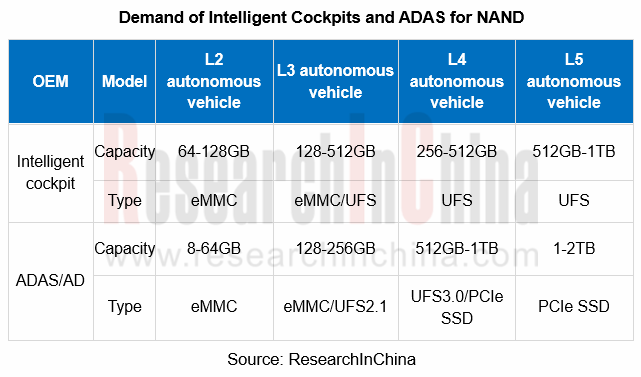
Autonomous vehicles boast more and more internal and external perception devices, including front cameras, internal cameras, high-resolution imaging radar, LiDAR, etc., and they will exploit high-density NOR Flash(QSPI, xSPI, etc., for chip startup) and DRAM(LPDDR3/4, LPDDR5, GDDR, etc.) widely.
At present, L1-L2 autonomous vehicles largely use LPDDR3 or LPDDR4, with the bandwidth of 25-50 GB/s. The bandwidth requirement is raised to 200GB/s for L3 autonomous driving, 300GB/s for L4 and 500GB/s for L5. Therefore, LPDDR5 and GDDR6 with higher bandwidth can simplify the system design of high-level autonomous vehicles.
Counterpoint’s data shows that in the next decade, the memory capacity of a single vehicle will reach 2TB~11TB, catering to the requirements of different autonomous driving levels.
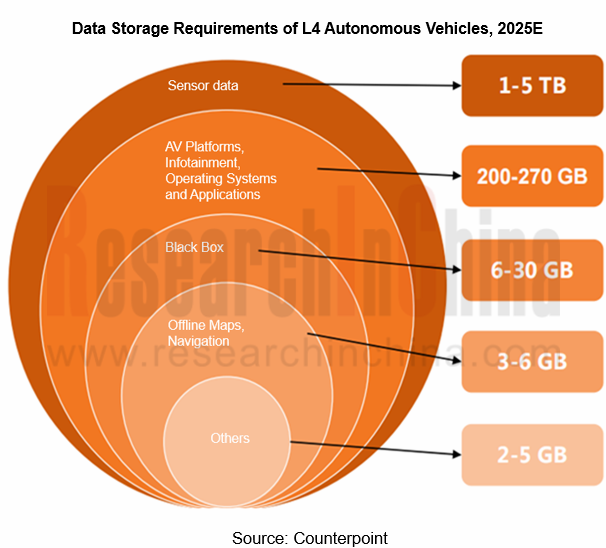
At the same time, autonomous driving is driven by data. The development of ADAS platforms needs massive road test data from cameras, radar, LiDAR, GPS and the like. These data are uploaded to the cloud for storage, AI training, simulation testing and verification. A one-hour L2 or L4-L5 road test probably generates 2TB or 16-20TB of data correspondingly, so that a single road test will produce 8-60TB of data, and the entire development cycle will churn out exabytes (EB) of data.
This has triggered huge market demand for autonomous driving cloud storage. In China, there are many cloud service providers that offer product solutions for autonomous driving data cloud storage, including Tencent Cloud, Alibaba Cloud, WD My Cloud, Sugon ParaStor, YRCloudFile, XSKY and so on.
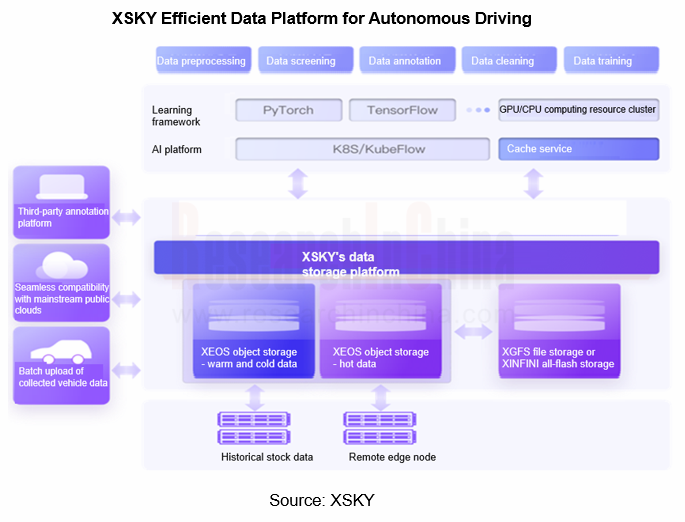
As the functions of intelligent cockpits become more and more diversified, larger storage capacity is constantly in demand, and storage technology is constantly innovating
With the wide application of central integrated digital cockpits, DRAM has evolved from DDR2 and DDR3 to LPDDR4, LPDDR5 or GDDR. In addition, the interface of mobile phones has transferred from eMMC to UFS, so will smart cockpit memory chips. It is also possible for high-end models to adopt PCIe SSD.
The cores of both UFS and eMMC interfaces involve NAND flash, but their control interfaces follow different protocols. The maximum communication rate of eMMC is 400MB/s, relative to 1,160 MB/s of UFS. The communication speed directly affects the startup time and software loading time of vehicles, which offer varying experience. In response to the demand for faster startup, reading and writing, the storage in the cockpit field must support UFS2.1 at least. Qualcomm's third-generation 8155 cockpit SoC has already endorsed UFS interfaces.
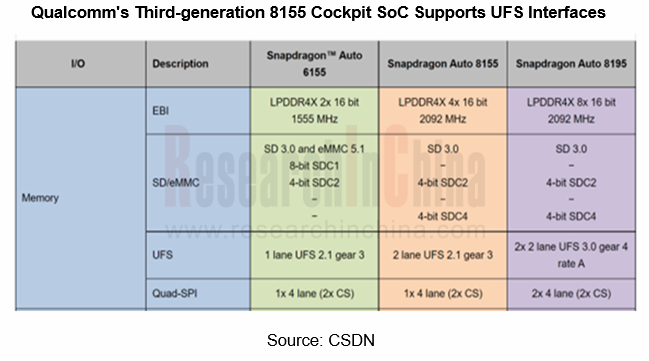
The intelligent cockpits of newly launched models demonstrate the increasingly powerful storage capacity:
?Xpeng P7 launched in 2020 is equipped with Qualcomm Snapdragon 820A with 8G memory + 128GB storage, enabling users to download more automotive Apps, supporting applet expansion, and featuring both practicality and fun;
?The next-generation SA8155P-based ZEEKR intelligent cockpit, available in ZEEKR 001 unveiled in 2021, has an 8-core CPU of the 7 nm process, with 16G memory and 128GB storage.
?Li L9 which debuted in 2022 comes standard with two Qualcomm Snapdragon 8155 chips with 24G memory and 256GB high-speed storage, which together form a powerful computing platform.

Chinese storage suppliers accelerate deployment in the promising automotive storage market
The requirements for automotive storage products are much higher than those for consumer electronics. Automotive-grade storage products have to take a long R&D and verification cycle, undergo a complicated certification process, comply with IATF16949, ASPCIE and ISO 26262, and satisfy the standards of some automakers, such as GMW3172 and VW80000. As a result, this market poses high barriers to entry and embodies obvious oligopoly.
Overseas storage vendors such as Micron, Samsung, SK Hynix and Microchip still dominate the development of the automotive storage industry as monopolists. Among them, Micron enjoys the global market share of over 45%. In 2021, Micron launched its industry-leading automotive LPDDR5 certified by ISO 26262 ASIL-D, with the maximum capacity of 128GB.
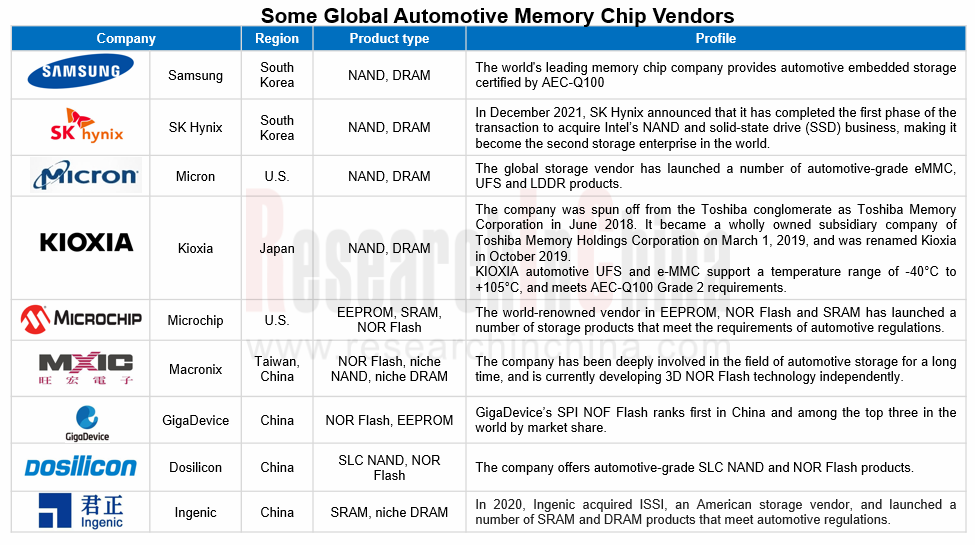
In recent years, Chinese memory chip vendors have made great efforts in automotive storage products:
SRAM: Ingenic has been focusing on independent CPU, SoC and AI engines for many years. In 2020, it acquired 100% stake in Beijing ISSI. By virtue of intellectual property rights, it can completely avoid the impact of the sanctions imposed by the United States government, independently develop and produce SRAM in line with automotive regulations, and produce niche DRAM. Ingenic has reached close cooperation with auto parts vendors such as Bosch and Continental.
EEPROM: Giantec Semiconductor, a leading EEPROM enterprise in China, launched GT24C512B, a high-reliability automotive A1-grade memory chip, in August 2022, which can withstand erasing and writing for up to 4 million times at room temperature, and has been applied to OBC, VCU and other related fields.
NOR Flash: GigaDevice has delved in the field of NOR Flash for many years. By market share, it ranks first in China and third in the world. The GD25 series launched by GigaDevice is the only mass-produced NOR Flash in China that meets AEC-Q100, with the storage capacity of 2Mb~2Gb.
In addition to OEMs, there is another type of storage players in China, like Longsys, BIWIN Storage Technology and Powe, who buy wafers and particles from IDMs and purchase master chips from third-party master chip vendors, then conduct packaging tests through their own or third-party packaging and testing factories, and produce storage products of different storage types, interfaces and standards.
Two-wheeler Intelligence and Industry Chain Research Report, 2023
In recent years, two-wheelers have headed in the direction of intelligent connection and intelligent driving, which has been accompanied by consumption upgrade, and mature applications of big data, ar...
Commercial Vehicle Telematics Industry Report, 2023-2024
The market tends to be more concentrated in leading companies in terms of hardware.
The commercial vehicle telematics industry chain covers several key links such as OEMs, operators, terminal device ...
Automotive Camera Tier2 Suppliers Research Report, 2023
1. Automotive lens companies: "camera module segment + emerging suppliers" facilitates the rise of Chinese products.
In 2023, automotive lens companies still maintain a three-echelon pattern. The fir...
China Passenger Car Navigate on Autopilot (NOA) Industry Report, 2023
Intelligent driving is evolving from L2 to L2+ and L2++, and Navigate on Autopilot (NOA) has become a layout focus in the industry. How is NOA advancing at present? What are hotspots in the market? Wh...
Automotive Telematics Service Providers (TSP) and Application Services Research Report, 2023-2024
From January to September 2023, the penetration of telematics in passenger cars in China hit 77.6%, up 12.8 percentage points from the prior-year period. The rising penetration of telematics provides ...
Passenger Car Intelligent Chassis and Chassis Domain Controller Research Report, 2023
Passenger Car Intelligent Chassis and Chassis Domain Controller Research Report, 2023, released by ResearchInChina combs through three integration trends of brake-by-wire, steer-by-wire, and active su...
Automotive Smart Cockpit Design Trend Report, 2023
As the most intuitive window to experience automotive intelligent technology, intelligent cockpit is steadily moving towards the deep end of “intelligence”, and automakers have worked to deploy intell...
China Automotive Multimodal Interaction Development Research Report, 2023
China Automotive Multimodal Interaction Development Research Report, 2023 released by ResearchInChina combs through the interaction modes of mainstream cockpits, the application of interaction modes i...
Automotive Smart Surface Research Report, 2023
Market status: vehicle models with smart surfaces boom in 2023
From 2018 to 2023, there were an increasing number of models equipped with smart surfaces, up to 52,000 units in 2022 and 256,000 units ...
Passenger Car Intelligent Steering Industry Report, 2023
Passenger Car Intelligent Steering Industry Report, 2023 released by ResearchInChina combs through and studies the status quo of passenger car intelligent steering and the product layout of OEMs, supp...
Automotive High-precision Positioning Research Report, 2023-2024
Autonomous driving is rapidly advancing from highway NOA to urban NOA, and poses ever higher technical requirements for high-precision positioning, highlighting the following:
1. Higher accuracy: urb...
New Energy Vehicle Thermal Management System Research Report, 2023
Thermal management system research: the mass production of CO? heat pumps, integrated controllers and other innovative products accelerates
Thermal management of new energy vehicles coordinates the c...
Commercial Vehicle Intelligent Chassis Industry Report, 2023
Commercial Vehicle Intelligent Chassis Industry Report, 2023, released by ResearchInChina, combs through and researches status quo and related product layout of OEMs and suppliers, and predicts future...
Chinese Independent OEMs’ ADAS and Autonomous Driving Report, 2023
1. Wide adoption of NOA begins, and local brands grab market share.
According to ResearchInChina, from January to August 2023, joint venture brands accounted for 3.0% of installations of L2.5 and hi...
Passenger Car Radar Industry, 2022-2023
Passenger Car Radar Industry Research in 2023:?In 2023, over 20 million radars were installed, a year-on-year jump of 35%;?Driven by multiple factors such as driving-parking integration, NOA and L3, 5...
Automotive Audio System Industry Report, 2023
Technology development: personalized sound field technology iteration accelerates
From automotive radio to “host + amplifier + speaker + AVAS” mode, automotive audio system has passed through several...
China Intelligent Door Market Research Report, 2023
China Intelligent Door Market Research Report, 2023 released by ResearchInChina analyzes and studies the features, market status, OEMs’ layout, suppliers’ layout, and development trends of intelligent...
Automotive Infrared Night Vision System Research Report, 2023
According to the data from ResearchInChina, during 2022-2023, the installations of NVS (night vision system) in new passenger cars in China went up at first and then down. From January to July 2022, t...